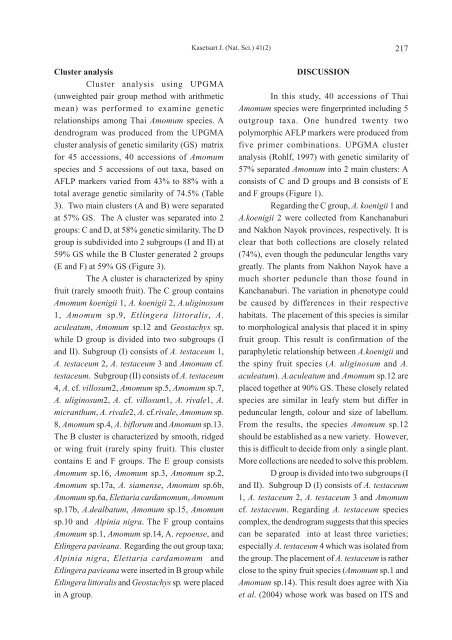April - June 2007 - Kasetsart University
April - June 2007 - Kasetsart University
April - June 2007 - Kasetsart University
You also want an ePaper? Increase the reach of your titles
YUMPU automatically turns print PDFs into web optimized ePapers that Google loves.
Cluster analysis<br />
Cluster analysis using UPGMA<br />
(unweighted pair group method with arithmetic<br />
mean) was performed to examine genetic<br />
relationships among Thai Amomum species. A<br />
dendrogram was produced from the UPGMA<br />
cluster analysis of genetic similarity (GS) matrix<br />
for 45 accessions, 40 accessions of Amomum<br />
species and 5 accessions of out taxa, based on<br />
AFLP markers varied from 43% to 88% with a<br />
total average genetic similarity of 74.5% (Table<br />
3). Two main clusters (A and B) were separated<br />
at 57% GS. The A cluster was separated into 2<br />
groups: C and D, at 58% genetic similarity. The D<br />
group is subdivided into 2 subgroups (I and II) at<br />
59% GS while the B Cluster generated 2 groups<br />
(E and F) at 59% GS (Figure 3).<br />
The A cluster is characterized by spiny<br />
fruit (rarely smooth fruit). The C group contains<br />
Amomum koenigii 1, A. koenigii 2, A.uliginosum<br />
1, Amomum sp.9, Etlingera littoralis, A.<br />
aculeatum, Amomum sp.12 and Geostachys sp.<br />
while D group is divided into two subgroups (I<br />
and II). Subgroup (I) consists of A. testaceum 1,<br />
A. testaceum 2, A. testaceum 3 and Amomum cf.<br />
testaceum. Subgroup (II) consists of A. testaceum<br />
4, A. cf. villosum2, Amomum sp.5, Amomum sp.7,<br />
A. uliginosum2, A. cf. villosum1, A. rivale1, A.<br />
micranthum, A. rivale2, A. cf.rivale, Amomum sp.<br />
8, Amomum sp.4, A. biflorum and Amomum sp.13.<br />
The B cluster is characterized by smooth, ridged<br />
or wing fruit (rarely spiny fruit). This cluster<br />
contains E and F groups. The E group consists<br />
Amomum sp.16, Amomum sp.3, Amomum sp.2,<br />
Amomum sp.17a, A. siamense, Amomum sp.6b,<br />
Amomum sp.6a, Elettaria cardamomum, Amomum<br />
sp.17b, A.dealbatum, Amomum sp.15, Amomum<br />
sp.10 and Alpinia nigra. The F group contains<br />
Amomum sp.1, Amomum sp.14, A. repoense, and<br />
Etlingera pavieana. Regarding the out group taxa;<br />
Alpinia nigra, Elettaria cardamomum and<br />
Etlingera pavieana were inserted in B group while<br />
Etlingera littoralis and Geostachys sp. were placed<br />
in A group.<br />
<strong>Kasetsart</strong> J. (Nat. Sci.) 41(2) 217<br />
DISCUSSION<br />
In this study, 40 accessions of Thai<br />
Amomum species were fingerprinted including 5<br />
outgroup taxa. One hundred twenty two<br />
polymorphic AFLP markers were produced from<br />
five primer combinations. UPGMA cluster<br />
analysis (Rohlf, 1997) with genetic similarity of<br />
57% separated Amomum into 2 main clusters: A<br />
consists of C and D groups and B consists of E<br />
and F groups (Figure 1).<br />
Regarding the C group, A. koenigii 1 and<br />
A.koenigii 2 were collected from Kanchanaburi<br />
and Nakhon Nayok provinces, respectively. It is<br />
clear that both collections are closely related<br />
(74%), even though the peduncular lengths vary<br />
greatly. The plants from Nakhon Nayok have a<br />
much shorter peduncle than those found in<br />
Kanchanaburi. The variation in phenotype could<br />
be caused by differences in their respective<br />
habitats. The placement of this species is similar<br />
to morphological analysis that placed it in spiny<br />
fruit group. This result is confirmation of the<br />
paraphyletic relationship between A.koenigii and<br />
the spiny fruit species (A. uliginosum and A.<br />
aculeatum). A.aculeatum and Amomum sp.12 are<br />
placed together at 90% GS. These closely related<br />
species are similar in leafy stem but differ in<br />
peduncular length, colour and size of labellum.<br />
From the results, the species Amomum sp.12<br />
should be established as a new variety. However,<br />
this is difficult to decide from only a single plant.<br />
More collections are needed to solve this problem.<br />
D group is divided into two subgroups (I<br />
and II). Subgroup D (I) consists of A. testaceum<br />
1, A. testaceum 2, A. testaceum 3 and Amomum<br />
cf. testaceum. Regarding A. testaceum species<br />
complex, the dendrogram suggests that this species<br />
can be separated into at least three varieties;<br />
especially A. testaceum 4 which was isolated from<br />
the group. The placement of A. testaceum is rather<br />
close to the spiny fruit species (Amomum sp.1 and<br />
Amomum sp.14). This result does agree with Xia<br />
et al. (2004) whose work was based on ITS and
















